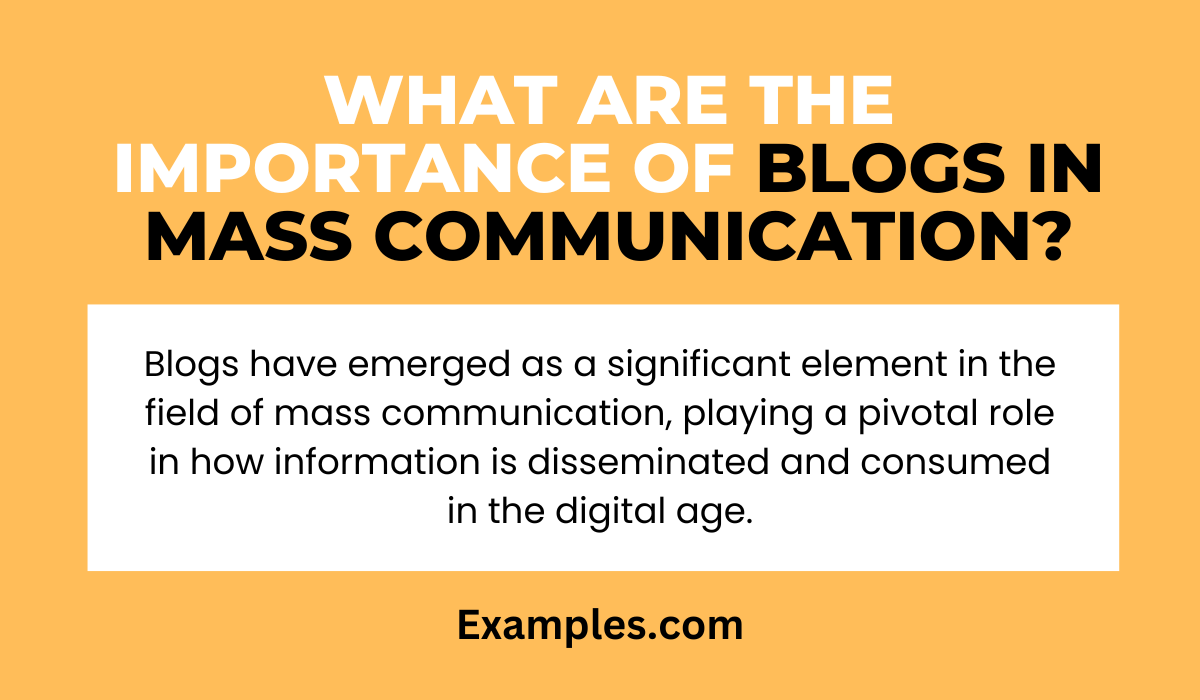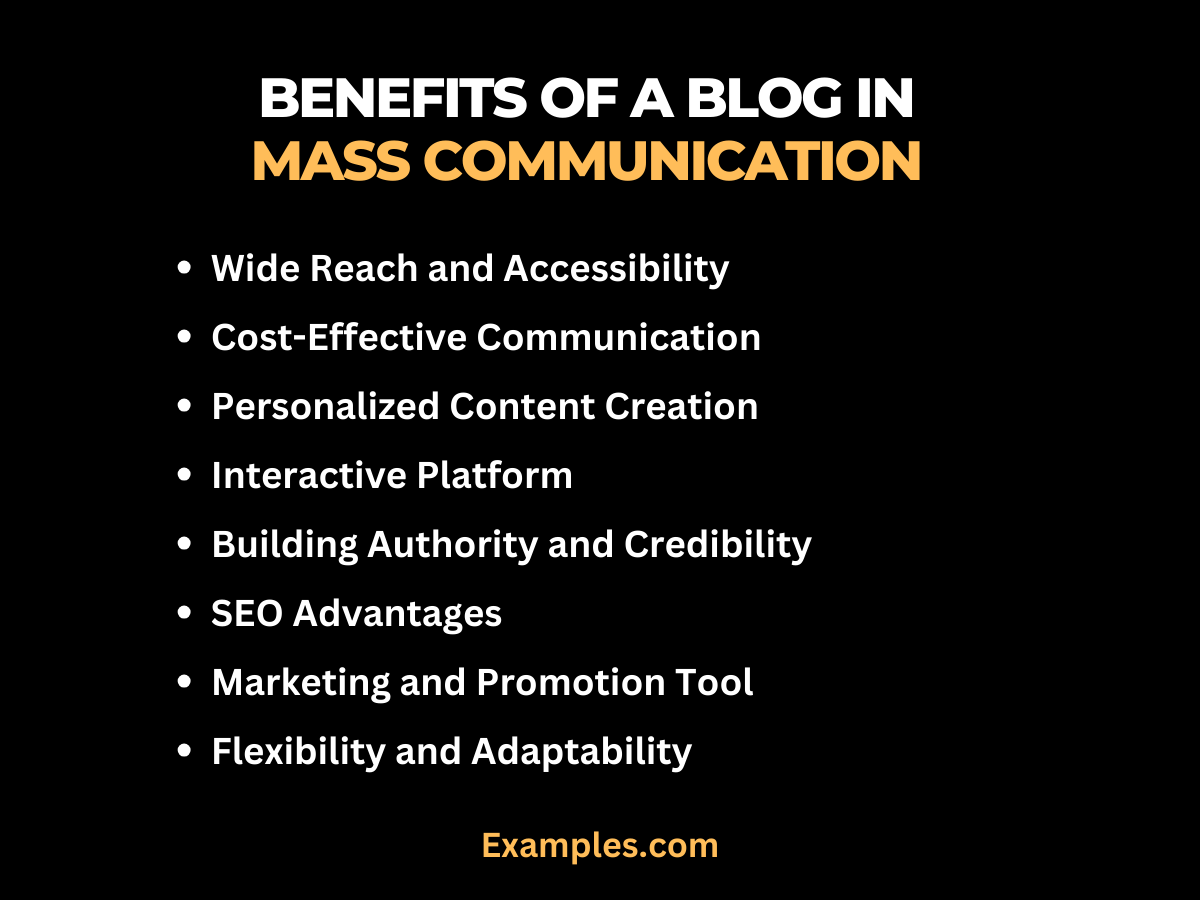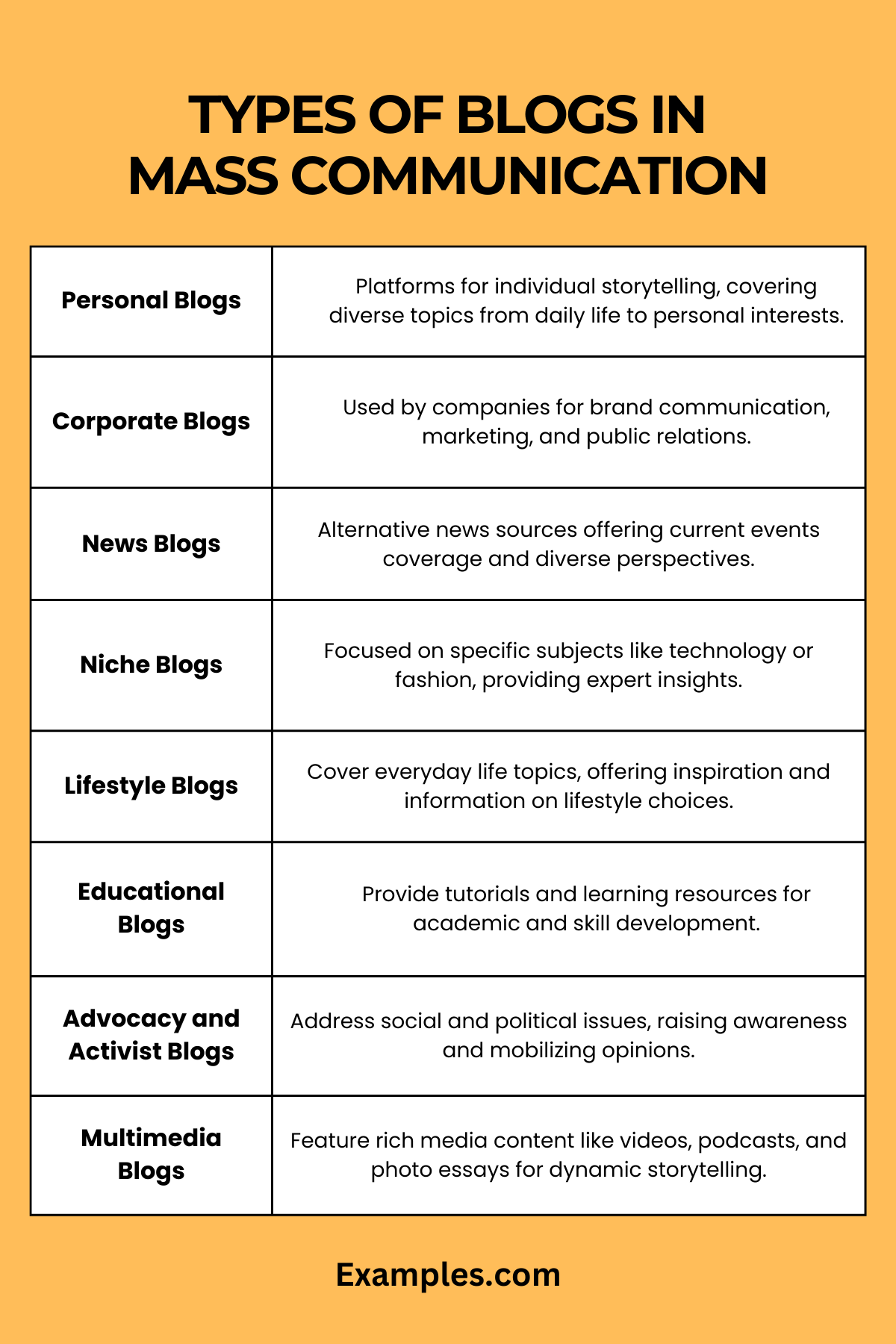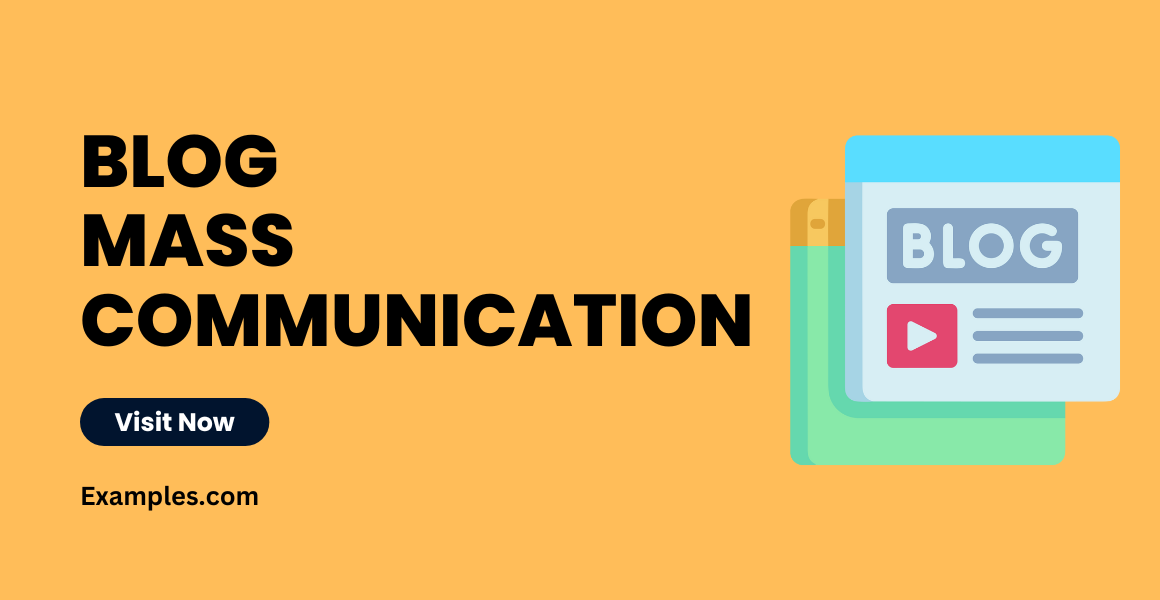Blog Mass Communication
In the digital era, blog mass communication stands out as a versatile and influential platform for sharing ideas, stories, and information. This guide dives into the world of blogging, a powerful tool in the mass communication landscape, offering insights on creating compelling content that resonates with a wide audience. Through practical communication examples, learn how to leverage blogging to effectively convey messages, engage readers, and influence public opinion. From personal blogs to corporate blogging, discover strategies to maximize the impact of your words in this dynamic form of digital communication.
What is a Blog in Mass Communication?
A blog in mass communication is a digital platform where individuals or organizations can publish content, ranging from written articles to multimedia posts. It serves as a powerful tool for sharing information, opinions, and insights with a broad audience over the internet. Blogs are unique for their informal, conversational style and the ability to engage directly with readers through comments and discussions. They have become a key component in the landscape of digital media, offering an accessible way for anyone to contribute to public discourse and express ideas on a global scale.
What are the Importance of Blogs in Mass Communication?
Blogs have emerged as a significant element in the field of mass communication, playing a pivotal role in how information is disseminated and consumed in the digital age. Their importance lies in several key aspects that contribute to the dynamics of modern communication.

Accessibility and Reach
- Global Accessibility: Blogs break geographical barriers, enabling content creators to reach a global audience with ease.
- User-Friendly Platforms: The simplicity of blogging platforms allows anyone with internet access to create and share content, democratizing the flow of information.
Personalization and Niche Targeting
- Niche Content: Blogs cater to specific interests or niches, connecting like-minded individuals and communities.
- Personalized Approach: The personal tone and style of blogs create a unique connection with readers, often leading to a loyal follower base.
Versatility and Diversity
- Diverse Content Forms: Blogs are versatile, encompassing various formats like text, images, videos, and podcasts.
- Platform for Creativity: They provide a creative outlet for individuals and organizations to express ideas and showcase expertise.
Engagement and Feedback
- Interactive Nature: Blogs encourage interaction and engagement through comments and social sharing, fostering a two-way communication stream.
- Feedback Mechanism: The immediate feedback received via comments or shares provides valuable insights into audience preferences and responses.
SEO and Online Presence
- Boosting Online Visibility: Regularly updated blogs contribute significantly to search engine optimization (SEO), enhancing online visibility.
- Content Marketing Tool: For businesses, blogs are an effective content marketing strategy to attract and engage customers.
Influence and Opinion-Shaping
- Platform for Thought Leadership: Blogs serve as platforms for thought leaders and experts to influence opinions and lead discussions on various topics.
- Shaping Public Discourse: Influential blogs have the power to shape public discourse and bring attention to important issues.
Source of Information and Education
- Informational Resource: Blogs often serve as a reliable source of information and learning on a wide range of subjects.
- Educational Value: Educational blogs provide valuable knowledge and insights, contributing to the learning process.
Blogs play a crucial role in mass communication by offering a platform that is accessible, personal, and interactive. They not only serve as a medium for sharing information but also for education, influence, and engagement, making them an integral part of the digital communication landscape.
What are the Benefits of a Blog in Mass Communication?
Blogging has emerged as a significant component in the realm of mass communication, offering numerous benefits that enhance the way information is shared and consumed. Here’s a detailed look at the advantages of using a blog in mass communication.

Wide Reach and Accessibility
- Global Audience: Blogs have the capability to reach a global audience, breaking geographical barriers and connecting people worldwide.
- Easy Access: With internet access, anyone can read a blog, making information readily available to a wide audience.
Cost-Effective Communication
- Low Start-up Costs: Starting a blog is relatively inexpensive compared to traditional media outlets.
- Economical Maintenance: Ongoing costs for maintaining a blog are minimal, making it a cost-effective communication tool.
Personalized Content Creation
- Creative Freedom: Bloggers have complete control over the content, style, and frequency of their posts.
- Niche Focus: Blogs can cater to specific interests or niches, attracting dedicated and engaged audiences.
Interactive Platform
- Audience Engagement: Blogs offer interactive features like comments and shares, allowing direct communication with readers.
- Feedback Opportunities: Immediate feedback from readers can guide content direction and improve engagement.
Building Authority and Credibility
- Expertise Showcase: Regular, insightful posts on a blog can establish the blogger as an authority in their field.
- Trust Building: Providing valuable and accurate information helps in building trust with the audience.
SEO Advantages
- Improved Search Rankings: Regularly updated, keyword-rich blog content can significantly improve search engine rankings.
- Increased Web Traffic: Effective SEO practices lead to increased visibility and higher web traffic to the blog.
Marketing and Promotion Tool
- Brand Promotion: Blogs are effective tools for promoting products, services, or personal brands.
- Content Marketing: They provide a platform for content marketing strategies, enhancing online presence and visibility.
Flexibility and Adaptability
- Versatile Content: Blogs can include various formats like text, images, videos, and links, making content dynamic and engaging.
- Adaptable to Trends: Blogs can quickly adapt to current trends, making them relevant and timely.
A Blog in mass communication offers numerous benefits, from reaching a global audience to providing a platform for personalized and interactive communication. Its role in establishing credibility, enhancing SEO, and serving as a marketing tool makes it an invaluable asset in the digital communication landscape.
What are the Types of Blogs in Mass Communication?
In the realm of mass communication, blogs vary widely in their focus and content, catering to diverse interests and audiences. Understanding the different types of blogs is essential for anyone looking to engage in this digital medium effectively.

Here’s a look at the various kinds of blogs that play a significant role in mass communication.
Personal Blogs
- Individual Expression: Personal blogs are often used by individuals to express their thoughts, experiences, and opinions. They are characterized by a personal touch and individual storytelling.
- Wide Range of Topics: These blogs can cover anything from daily life experiences to specific hobbies or interests.
Corporate Blogs
- Brand Communication: Corporate blogs are used by companies to communicate with their customers, providing updates, industry insights, and brand-related information.
- Marketing and PR Tool: They serve as a marketing tool to enhance brand visibility and as a PR channel for corporate communication.
News Blogs
- Current Events Coverage: News blogs focus on covering current events, offering an alternative to traditional news outlets.
- Diverse Perspectives: These blogs often provide unique perspectives or specialized reporting on various news topics.
Niche Blogs
- Focused Content: Niche blogs concentrate on a specific subject area, such as technology, fashion, travel, or food.
- Expert Insights: They often offer expert insights and detailed information about their particular niche.
Lifestyle Blogs
- Everyday Life and Interests: Lifestyle blogs cover topics related to daily living, such as wellness, home decor, and personal development.
- Inspirational and Informative: These blogs aim to inspire and inform readers about lifestyle choices and practices.
Educational Blogs
- Informative and Educational Content: Educational blogs provide learning resources, tutorials, and informative content on various educational topics.
- Academic and Skill Development: They are used for academic purposes and skill development.
Advocacy and Activist Blogs
- Social and Political Issues: These blogs focus on advocating for specific causes or discussing social and political issues.
- Awareness and Mobilization: They aim to raise awareness and mobilize public opinion on their chosen causes.
Multimedia Blogs
- Rich Media Content: Multimedia blogs use various media forms like videos (vlogs), podcasts, and photo essays.
- Engaging and Dynamic: This format offers a more engaging and dynamic way to present content.
Each type of blog in mass communication serves a unique purpose, from personal expression and corporate branding to news dissemination and educational content. Bloggers choose their type based on their objectives, audience, and content style, contributing to the diverse and vibrant landscape of digital communication in the modern world.
How to Use Blog in Mass Communication?
Using a blog in mass communication is an effective way to reach and engage a wide audience. A blog can be a versatile tool, whether for personal expression, corporate communication, or journalistic reporting. Here’s how to maximize the potential of blogging in the field of mass communication.
Identifying Your Niche and Audience
- Target Audience Identification: Understand who your blog is aimed at. Is it for professionals in a specific field, enthusiasts of a certain hobby, or the general public?
- Niche Focus: Specialize in a specific area of interest to stand out. This could be anything from tech reviews to lifestyle and travel.
Creating Engaging Content
- Content Planning: Develop a content calendar to maintain a consistent posting schedule.
- Quality Over Quantity: Focus on creating high-quality, informative, and engaging content that adds value to your readers.
Enhancing Visibility
- SEO Strategies: Utilize search engine optimization (SEO) techniques to improve your blog’s visibility on search engines.
- Social Media Integration: Share your blog posts on social media platforms to reach a larger audience and drive traffic to your blog.
Building a Community
- Encourage Interaction: Engage with your readers through comments and discussions to build a community around your blog.
- Feedback and Adaptation: Listen to your audience’s feedback and adapt your content accordingly.
Utilizing Multimedia Elements
- Visual and Audio Enhancements: Incorporate images, videos, and podcasts to make your blog more appealing and engaging.
- Infographics and Data Visualization: Use infographics for complex data or information to make your content more understandable and shareable.
Staying Current and Relevant
- Trend Monitoring: Stay updated with the latest trends in your niche and the blogging world.
- Continuous Learning: Attend webinars, workshops, and courses to enhance your blogging skills and knowledge.
Measuring Success
- Analytics Tools: Use tools like Google Analytics to track your blog’s performance and understand your audience better.
- Goal Setting: Set clear objectives for your blog, whether it’s building an audience, generating leads, or establishing thought leadership.
Ethics and Credibility
- Fact-Checking: Always verify your information to maintain credibility.
- Transparency and Ethics: Be transparent about any sponsorships or advertisements and adhere to ethical standards of communication.
Incorporating a blog into mass communication strategies offers a unique and personal way to connect with an audience. By focusing on creating valuable content, enhancing visibility, and fostering community engagement, blogging can become a powerful tool in the mass communication toolkit.
Tips for Writing Blogs in Mass Communication
Writing blogs in mass communication is an art that combines creativity with strategic communication. To make your blog stand out in the crowded digital space, it’s important to understand and implement certain key practices. Here are some essential tips for writing effective blogs that can engage and inform a wide audience.
Understand Your Audience
- Audience Analysis: Identify and understand your target audience. Know their interests, needs, and online behavior to tailor your content accordingly.
- Engagement Strategies: Use a tone and language that resonate with your audience, encouraging interaction and engagement.
Choose Relevant Topics
- Trending Topics: Stay updated with current trends and discussions relevant to your audience and industry.
- Evergreen Content: Also include evergreen topics that remain relevant over time, attracting continuous traffic to your blog.
Focus on Quality Content
- Informative and Valuable: Ensure your blog posts are informative, providing value to your readers.
- Originality: Be original in your content. Unique perspectives and insights can set your blog apart.
Optimize for Search Engines
- SEO Practices: Implement Search Engine Optimization (SEO) techniques, such as using relevant keywords, to increase your blog’s visibility on search engines.
- Mobile Optimization: Ensure your blog is mobile-friendly, as a significant portion of users access content on mobile devices.
Engage with Visuals
- Use of Multimedia: Integrate visuals like images, videos, and infographics to make your blog more engaging and easier to digest.
- Visual Consistency: Maintain a consistent visual style that reflects your brand or personal blogging identity.
Encourage Interaction
- Comments and Feedback: Invite readers to comment and provide feedback. Engage with them by responding to comments.
- Social Sharing: Include social sharing buttons to encourage readers to share your content on their networks.
Regular Updates and Consistency
- Consistent Posting: Maintain a regular posting schedule. Consistency helps in building a loyal audience.
- Content Calendar: Use a content calendar to plan and organize your posts effectively.
Monitor and Adapt
- Analytics: Use analytics tools to track your blog’s performance. Understand what works and what doesn’t.
- Flexibility: Be open to adapting your content strategy based on analytics and audience feedback.
Promote Your Blog
- Social Media and Email Marketing: Utilize social media and email marketing to promote your blog posts.
- Collaborations: Collaborate with other bloggers or influencers to expand your reach.
Writing a successful blog in mass communication involves a blend of audience understanding, content quality, SEO, visual engagement, and strategic promotion. By following these tips, you can create a blog that not only attracts but also retains a wide and engaged audience.



